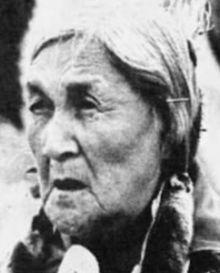
The Piegan are an Algonquian-speaking people from the North American Great Plains. They are the largest of three Blackfoot-speaking groups that make up the Blackfoot Confederacy; the Siksika and Kainai are the others. The Piegan dominated much of the northern Great Plains during the nineteenth century.

The Blackfoot Confederacy, Niitsitapi, or Siksikaitsitapi, is a historic collective name for linguistically related groups that make up the Blackfoot or Blackfeet people: the Siksika ("Blackfoot"), the Kainai or Blood, and two sections of the Peigan or Piikani – the Northern Piikani (Aapátohsipikáni) and the Southern Piikani. Broader definitions include groups such as the Tsúùtínà (Sarcee) and A'aninin who spoke quite different languages but allied with or joined the Blackfoot Confederacy.

The Kainai Nation is a First Nations band government in southern Alberta, Canada, with a population of 12,800 members in 2015, up from 11,791 in December 2013.

The Blackfoot language, also called Siksiká, often anglicised as Siksika, is an Algonquian language spoken by the Blackfoot or Niitsitapi people, who currently live in the northwestern plains of North America. There are four dialects, three of which are spoken in Alberta, Canada, and one of which is spoken in the United States: Siksiká (Blackfoot), to the southeast of Calgary, Alberta; Kainai, spoken in Alberta between Cardston and Lethbridge; Aapátohsipikani, to the west of Fort MacLeod which is Brocket (Piikani) and Aamsskáápipikani, in northwestern Montana. The name Blackfoot probably comes from the blackened soles of the leather shoes that the people wore.
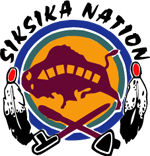
The Siksika Nation is a First Nation in southern Alberta, Canada. The name Siksiká comes from the Blackfoot words sik (black) and iká (foot), with a connector s between the two words. The plural form of Siksiká is Siksikáwa. The Siksikáwa are the northernmost of the Niitsítapi, all of whom speak dialects of Blackfoot, an Algonquian language.
Shawnee Slopes is a residential neighbourhood in the southwest quadrant of Calgary, Alberta, Canada. It is bounded to the south by James McKevitt Road, to the east by Macleod Trail, to the north by Fish Creek Provincial Park and to the west by Evergreen Street SW.

The Aryan Guard was a neo-Nazi terrorist organization based in Alberta, Canada, whose members are primarily located in the city of Calgary. It was founded in late 2006, and was reported to have disbanded in 2009 as a result of internal conflict including pipe bombing attacks. However, late in 2009 the group denied this and claimed it was still operating.
Three members of the Richardson family were murdered in Medicine Hat, Alberta, Canada in April 2006. The murders were planned and committed by the family's 12-year-old daughter Jasmine Richardson and her 23-year-old boyfriend Jeremy Steinke, now going by the name Jackson May. Richardson and Steinke were each convicted on three counts of first-degree murder. Richardson, who had turned 13 before being convicted, is thought to be the youngest person in Canada ever convicted of multiple first-degree murder counts. Her 10-year sentence was completed on May 6, 2016.
Martindale is a CTrain light rail station in Martindale, Calgary, Alberta. It serves the Northeast Line. It opened August 27, 2012.
Mînî Thnî is a First Nations settlement within the Stoney 142/143/144 Indian reserve in southern Alberta, Canada. It is located along the Canadian Pacific Kansas City railway between the Trans-Canada Highway and the Bow River, upstream from Ghost Lake. It has an elevation of 1,240 metres (4,070 ft). The settlement is located in census division No. 15 and in the federal riding of Wild Rose. The settlement and the Indian reserve are part of the Stoney Nation.
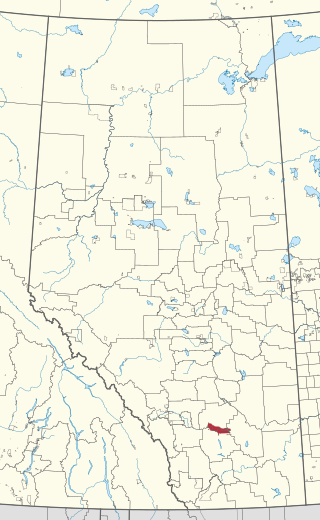
Siksika 146 is a First Nations reserve of the Siksika Nation in southern Alberta, Canada. It is 87 km (54 mi) southeast of Calgary at an elevation of 857 m (2,812 ft).
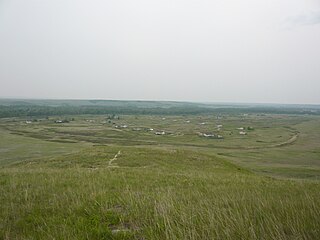
Blackfoot Crossing Historical Park is a complex of historic sites on the Siksika 146 Indian reserve in Alberta, Canada. This crossing of the Bow River was traditionally a bison-hunting and gathering place for the Siksika people and their allies in the Blackfoot Confederacy.
Ben Calf Robe was a Blackfoot (Siksika) elder, residential school survivor, and scout for the North West Mounted Police.
Brittney Bear Hat is a half Blackfoot, half Cree artist. She makes work in a variety of media, including photography, installation and video, as a means to explore how memory and personal identity construct her Native identity.
Richelle Bear Hat is a Blackfoot and Cree artist, based in Calgary, Alberta, Canada, on Treaty 7 territory. Bear Hat's work explores the ancestral transmission of knowledge, memory, and Indigenous relationships to land. According to curator Kristy Trinier, "her practice investigates ideas surrounding family relationships and the types of knowledge that are capable of being passed through them. These ideas are explored through the use of photography, transfers, video and paper based works. It is important to use materials and means of production that support the transference of memory and provide a platform for storytelling."
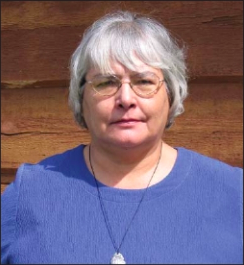
Marie Smallface Marule was a Canadian academic administrator, activist, and educator. She served as executive director of the National Indian Brotherhood (NIB), chief administrator of the World Council of Indigenous Peoples (WCIP), and secretary of the Indian Association of Alberta. Marule was president of Red Crow Community College for two decades, and led the creation of several indigenous studies programs. She was previously an assistant professor of Native American studies at the University of Lethbridge.
Adrian Stimson is an artist and a member of the Siksika Nation.

Gina McDougall was a U.S.-born Canadian sculptor, rancher and horse trainer. She was a 2-time Canadian barrel racing champion in 1962 and 1963. The Calgary Stampede and Red Deer Silver Buckle Rodeo commissioned bronzes from her, and she had pieces in the private collections of Queen Elizabeth, Princess Margaret, and Randy Travis. She was inducted into the Calgary Stampede Western Art Show Hall of Fame in 2007 and the Canadian Pro Rodeo Hall of Fame in 2013.
Roy Little Chief was a Canadian Siksika elder and former Chief of the Siksika Nation from 1981 to 1983. He was a longtime activist for the rights of First Nations and indigenous people in Canada.
Margaret Waterchief was a Blackfoot elder and Anglican priest. A member of the Siksika Nation and the Piikani Nation, Waterchief attended the St. Cyprian's Anglican Residential School in Piikani until the age of 17. As a residential school student she was discouraged from speaking the Blackfoot language and was prevented from seeing her family, who lived nearby, beyond a few hours each Saturday. After graduating she relocated to Siksika, where she met and married Raymond Waterchief, with whom she had 10 children. Both struggled with alcoholism. Following Raymond's death in 1976 at the age of 42, Waterchief drank for several years before getting sober and turning more actively to the Anglican church. She served as a counsellor for those also dealing with alcoholism and as a lay Anglican pastor.
